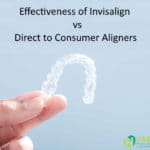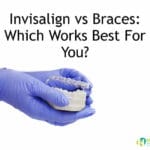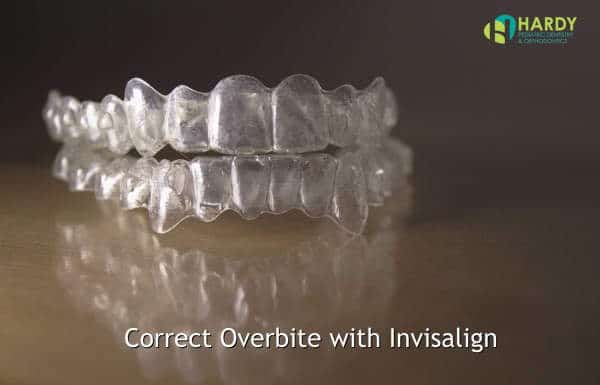A malocclusion in which the upper front teeth overlap the lower front teeth is known as an overbite. It is the most common dental problem, accounting for more than 70% of all dental problems and resulting in an uneven and unnatural smile. We’re here to help you figure out if clear aligners like Invisalign can help you with overbite or deep bite.
See if 5 Reasons You Should Choose Invisalign.
Correcting an Overbite with Invisalign
Without the use of brackets or wires, Invisalign is a simple but efficient way to straighten teeth..
To use Invisalign to correct an overbite, you must first arrange a consultation. You must visit the office to determine whether or not you are a good candidate for this procedure. If you qualify, your orthodontist will use a digital scan of your teeth to create a virtual 3D model of your teeth. After you’ve decided on an orthodontic treatment plan, your aligners will be made using cutting-edge technology.
You must wear your aligners for a total of 21 hours every day, removing them only to eat, brush, and floss your teeth. Every two weeks, you’ll get a new set, and as you progress, it’ll gradually push your teeth into the proper position.
Read differences between Invisalign and Smile Direct Club
Does Invisalign help other bite problems?
Invisalign can correct the following biting difficulties when applied by a trained professional:
For Underbite
In an underbite, the lower teeth overlap the upper teeth. Underdevelopment of the upper, lower, or both jaws is the most common cause of this condition. Flared lower incisors, tipped rear incisors, a missing upper half, or a combination of these disorders can all contribute to this condition.
Underbite needs to be corrected immediately because:
-
-
- It prevents the correct functions of the mouth.
- Your smile is less attractive
- Can cause jaw-joint dysfunction.
-
For Crossbite
A crossbite occurs when the upper teeth bite against the inside of the lower teeth. This is only feasible on the mouth’s front sides. It’s best if you get it corrected as soon as possible.
Crossbites can cause the following:
-
-
-
- When the teeth have premature wear
- Less attractive smile
- Gum disease
- Bone loss
- Weak chewing patterns
- Asymmetrical jaw development causing irregular facial features
- Temporomandibular joint (TMJ) disorders
-
-
Open Bite Malocclusion
When the upper and lower jaws are forced outward to the point where they don’t meet when you close your mouth, this problem occurs. The timing of Invisalign treatment is crucial to its success.
If this condition is not treated, it can cause the following
-
-
-
- Premature wear of the molar (tooth).
- A less beautiful smile.
- Jaw joint dysfunction
-
-
Read choosing between Invisalign and braces
Gaps in teeth, Diastema
Tooth gaps, also known as diastema, are a dental condition in which two or more teeth have a perceptible space between them. The two front incisors share this space. Diastema is a common and minor type of misaligned tooth that Invisalign can correct.
Invisalign express can be used to address a tiny dental issue that usually affects only a few teeth and is not caused by a bite misalignment or other complications.
Dentists will use elastics or attachments to augment Invisalign when a more sophisticated movement of the teeth or jaw is required. These are tooth-colored attachments that enable complicated tooth movement.
Correcting an Overbite: Expectations with Invisalign
Dentists will use elastics or attachments to augment Invisalign when a more sophisticated movement of the teeth or jaw is required. These are tooth-colored attachments that enable complicated tooth movement.
Is Invisalign for complex bite problems?
While Invisalign can address many difficulties, it cannot correct all of them, in which case traditional braces are the best solution. If the overbite is severe enough to warrant surgical treatment, for example. Invisalign will not be able to straighten crowded teeth that necessitate a lot of rotation. Invisalign may tolerate small gaps, but excessive gaps can cause it to fail. Invisalign may not be successful in correcting more than a 2mm gap or raising or lowering tooth position.
Schedule an appointment at Hardy Pediartic Dentistry & Orthodontics.
Source:
- The Invisalign system in adult orthodontics: mild crowding and space closure cases.
J Clin Orthod. 2000; 34: 203-212 - The treatment effects of Invisalign orthodontic aligners: a systematic review.
 What is The Difference Between Invisalign and Direct to Consumer Aligners
What is The Difference Between Invisalign and Direct to Consumer AlignersDespite the fact that they are both transparent aligners, these two devices are extremely different. Examine the differences between Invisalign and Direct to Consumer Aligners to choose which is best for you. How Effective is Invisalign Vs Direct to Consumer Aligners Invisalign and Direct to Consumer Aligners are both forms of transparent aligners used to […]
 Invisalign vs Braces : Which One is Best For You?
Invisalign vs Braces : Which One is Best For You?According to studies, 96 percent of people believe that their smile is vital to their overall appearance. As a result, individuals opt to use braces or Invisalign in order to achieve perfectly aligned teeth. But which option, between Invisalign and braces, is the most appropriate for you? Advantages and Disadvantages of Invisalign over Braces Invisalign […]

